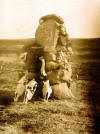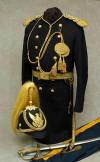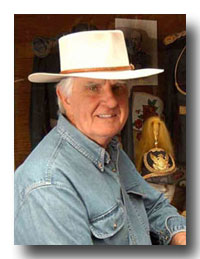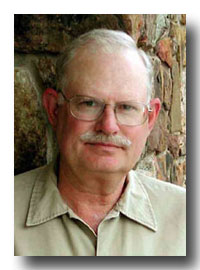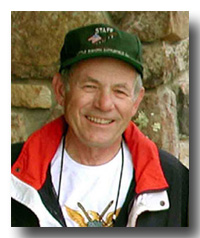| Friends Of The Little Bighorn Battlefield |
The Next Generation In The Study Of Custer's Last Stand |
G.A. Custer: His Life & Times |
| • The Battle • Archeology • Memorials • Little Bighorn Store • News • Book Reviews |
More to See >> Front Flap
of BookBy Glenwood J. SwansonBook Review by Bob Reece, September 2004
"...The field glasses were carried by Benteen and are mentioned when they are lent to Lt. Frank Gibson who was detailed with Benteen. These along with several other items are all that remain of his personal effects. His son, Freddie, told Custer historian Colonel Graham in 1920 that everything else burned in a fire at their home in Atlanta. Benteen wrote the text of Custer's famous message in the margin of a story about the Bighorn Battle, written by Pvt. Theo Goldin." from G. A. Custer: His Life and Times
Glen Swanson’s “G. A. Custer: His Life and Times” is rich with historic material. Don’t let the title fool you; this 11 X 9 inch hardbound book is a must-have for every Battle of the Little Bighorn enthusiast. In an interview I had with Glen Swanson he stated:
As I read and gazed upon this book, I found myself treating it with careful hands. I savored it like a dram full of a well-aged single-malt scotch. The characters in this story come vividly alive through many superb photographs - all shot by Swanson - of their personal effects from 128 plus years ago. The first chapter, “Custer: Young Cadet to Frontiersman in Buckskin”, covers the life of George Armstrong Custer in the Civil War and Plains Indian Wars. You’ll find many photographs of family portraits, buffalo hunting parties, and his personal effects. Included are photos of Custer’s commission rank promotions signed by Presidents Lincoln and Johnson. The color photo of Custer’s Tiffany sword will take your breath away.
Custer's Tiffany Sword
Capturing the imagination of the reader is easy when one gazes upon a full-length view of the front and back of Custer’s second buckskin jacket. Or, viewing a photo of a monument constructed by 1st Lt. Hugh L. Scott at the Washita Battlefield in 1890. Many a friend found it hard to believe when I told them that the battlefield archives kept locked up Custer’s own “army supplied truss” (Jockstrap). The reader can finally see a picture of the truss for the first time.
Hugh Scott's Washita Battlefield Monument
Chapter two, “Of Garry Owen In Glory: The Seventh Cavalry’s Officer Corps”, presents the photographs by officer. Starting with Captain Benteen, and ending with Col. Samuel D. Sturgis the reader is treated to photos of Tom Custer’s Congressional Medals of Honor and Keogh’s cavalry saber, left on the steamer Far West before marching up the Rosebud to the Little Bighorn. Keogh’s saber was “later sent to his family in Ireland by his friend Henry Nowlan.” The reader will also discover photos of officers of the 7th who didn’t march with the 7th to the Little Bighorn. One of those officers is 1st Lt. Henry J. Nowlan who served with General Terry’s staff on June 25, 1876. For Reno fans, you’ll view his cavalry kepi and his satchel with his initials needle pointed by his sister, Mrs. Cornelia Knowles. 2nd Lt. William Van Wyck Reily’s ring worn during the battle is included. “The ring was recovered from a Northern Cheyenne Indian who surrendered at Fort Robinson, Nebraska, almost two years after the battle.” The simple pleasures of life for the cavalryman are represented by Captain George W. Yates and Captain Weir's pipes.
Captain Weir's well-used pipeJump here to learn about tobacco use in the 7th Cavalry A reminder of those that fell on June 25, 1876 is 2nd Lt. John J. Crittenden’s grave at Calhoun Hill. The photo taken at the turn of the century and published for the first time shows a barbed-wired fence encircling the grave. Other photos from chapter two include:
Varnum's 1881 officer's tunic, 1872 dress sword, 1881 pattern officer's helmet
Chapter three, “The Enlisted Men of the Seventh Cavalry”, is a wonderful treasure trove of never-before-published photographs of Medals of Honor, a spur with the initials “W” and “I” (found in 1995), and of the men themselves. The companies of the 7th Cavalry make each section of chapter three. There is even one section of photographs for the “Unidentified.” Chapter four, “Victors and Vanquished: Survivors’ Sagas”, begins with striking photos of Sheridan, Grant, Crook, Sherman, and more; all are reproduced at an exceptional quality never seen before. These photos of these great men look like they were developed for the first time today. Also included in chapter four are never-before-published photos of the Arikara and Crow scouts. The reader can even gaze on the discharge papers for the Arikara scout, Round Wooden Leg signed by Major Marcus Reno. Other photos included in chapter four:
Sitting Bull's autograph, beaded bags, and rosary
Page 213 of chapter four has a full-page color photo that makes purchasing this book more than worthwhile. It’s a brass plate with an etched drawing depicting a running fight between Indians and cavalry soldiers. I was fortunate to hold this in my hands the evening this item was found by Jason Pitsch. Pitsch owned the land that included Sitting Bull’s village, the timber from which Reno would retreat, and the path of his retreat up to the west bank of the Little Bighorn River. Pitsch became interested in the battle and began to metal detect his own land. He found countless artifacts with many being battle related or Indian village related. Pitsch found this brass plate in the area of what was Sitting Bull’s village. Pitsch was excited about his find so he went looking for archeologist Richard Fox. He found Fox, another individual, and myself enjoying our evening meal in a Hardin, Montana eatery. We took the brass plate into a room of the restaurant that provided better light. It was impossible to see anything, although Pitsch said something was etched on it. Fox poured water over the brass plate and shifted it in the light until all could see what was there. We all gasped. There it was; a dramatic fight with arrows flying through the air, soldiers riding for their lives with arrows stuck in their backs, and warriors in hot pursuit of the fleeing cavalrymen. On the ground, of the image, was a dead soldier and near him a bugle. We couldn’t believe what we saw. Fox explained it might be a drawing of the Rosebud Fight left behind as Sitting Bull and his village left the valley of the Little Bighorn River. The image could also represent Major Reno’s retreat during the Valley Fight of June 25, 1876. We’ll never know, but you should know this; you’ll never see a photo of this mysterious brass plate in any other book except this one. Also included in chapter four is a photo that fully captures the mystery and myth of the battle. It’s a 7th Cavalry guidon that was originally found in American Horse’s village after the Battle of Slim Buttes. Although it is now known as the "Keogh Guidon" -- supposedly carried into battle by Keogh’s Company I -- we really do not know if that is the case. "Keogh Guidon" was so named because personal items that belonged to Captain Myles Keogh were found along with the guidon. Actually, the guidons carried by the 7th Cavalry into the Battle of the Little Bighorn did not designate a company letter. These guidons were basically a swallow tail flag with red stripes and a field of stars. By the time this mysterious article was finally presented to the battlefield museum, it was in terrible, moth-eaten condition. I’ve had the rare opportunity to work in the archives and visit countless times over the years. And, on many of those occasions, I looked upon this guidon. Very few people have had this chance, but now you do. Swanson includes a striking photo of the Keogh Guidon, and as many times as I’ve seen it, I felt like I was looking at it for the first time through Swanson’s lens. Swanson’s lighting and camera-work bring out the most of the guidon. The Keogh Guidon is another photo that makes it worth the purchase price of this book. There is one other important flag kept at the battlefield archives. This one is in much better shape and its photo included in the book is exceptional. It’s the Regimental Standard. Both of these flags are in need of major repair – the Keogh Guidon will probably require the most work. The Friends of the Little Bighorn Battlefield will do all it can to contribute to the cost for their restoration.
"Keogh Guidon"Near the end of chapter four, and reproduced in its entirety, is the easy-to-read July 20, 1877 report from Captain Michael Sheridan to his brother, Phillip Sheridan. This handwritten letter covers Michael Sheridan’s mission of recovering the officer’s remains, and placing them in pine coffins to bring back east. Chapter five, “Men With Custer: The Dead Tell Their Tale”, is written by Douglas D. Scott (retired Great Plains Team Leader, Midwest Archeological Center, National Park Service). Scott discusses the analysis of the remains found of Custer’s men and of some identified. The chapter also includes photos of many of the artifacts found on the battlefield. This chapter also includes the amazing story of the discovery of Pvt. John Sivertsen’s cavalry horse, his personal effects, and ammunition. There is a photo of Siversten’s horse bones including “the 45 caliber ball which was found in the horse’s skull.” Douglas Scott and Little Bighorn Battlefield firearms expert, Dick Harmon, write the final chapter, “Firearms and Fields of Fire.” There are many photos of guns actually used in the battle by soldiers and warriors. There is one carbine featured in this chapter that brings the reader closer to June 25, 1876 than ever before. It’s a Springfield U. S. Model 1873 carbine, serial number 19573. Carved into the left side of the forearm is, “J. Martin.” Dick Harmon’s research pinpoints the weapon being used by either John Martini (who carried the last written message from Custer to Benteen), or James Martin. But, we’ll probably never know – it's just another mystery of the Battle of the Little Bighorn waiting to be solved. You might think that I’ve discussed everything that’s included in this book, right? Well, no I haven’t. I’ve just touched the tip of the iceberg. There is so much more you’ll find of rare, never-before-published photos and descriptive text from primary sources. There are countless books you can find about George Custer, photos of Custer, the 7th cavalry, and the Indians who fought at the Battle of the Little Bighorn. However, there is only one book like this one. Glen Swanson’s, “G. A. Custer: His Life and Times” is a rare jewel in a large collection of diamonds.
Gun No. 14 -- Springfield U.S. Model 1873 Carbine, Serial Number 1210
Available Now -- How To OrderFirst Edition, 2500 hardcover copies -- $100 Leather Bound Limited Edition, 150 signed and numbered copies -- $175 Send check or money order + $7 shipping and handling for Domestic orders or $8.75 for international orders to: Swanson
Productions Or pay by Visa or Mastercard by visiting Glen Swanson's new website: www.swansonproductions.com
Books On The Horizon Home |
|
|
|
Copyright 1999-2013 Bob Reece Friends Little Bighorn Battlefield, P.O. Box 636, Crow Agency, MT 59022 | Home |
Board of Directors |
Guest Book | Contact | Site Map
| |
||


_small.jpg)
